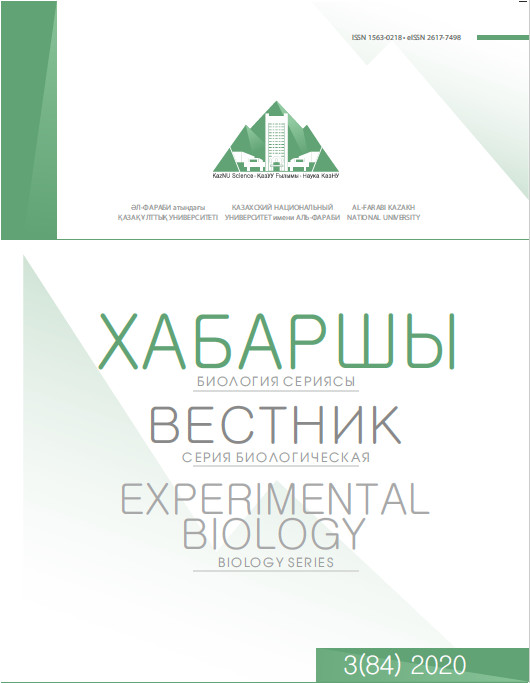Biochemical and anatomical research of Kazakhstan Seriphidium heptapotamicum (Asteraceae)
DOI:
https://doi.org/10.26577/eb.2020.v84.i3.02Abstract
Currently, the study of the structure and composition of plants is very important for medicine, perfumery, farms, etc. The section of the Asteraceae family includes Seriphidium heptapotamicum (Poljak) Ling & Y.R. Ling. This study discusses biochemical and anatomical features. According to new observations, the the previous description of the species was added by the additional information. Anatomical studies were carried out by the vegetative organs of S.heptapotamicum using the paraffin method. The anatomy of S.heptapotamicum have not been studied. Anatomically, the root cross section has the epidermis as a protective tissue in the outer layer and the endodermis is not clearly seen. The stems have a thick, well-developed layer of sclerenchyma. Leaves are equilateral. For a biochemical study, the essential oil was isolated from the aerial parts of S.heptapotamicum using a Clevenger type apparatus. The yield of S.heptapotamicum essential oil was found to be 2.4 %. The chemical composition of the essential oil was analyzed by GC-FID and GC-MS simultaneously. The chemical composition of essential oil depends on the collectionsites. The essential oil is composed of 14 components, in which the major dominant constituents were Thujone-41.10%, 1,8-Cineole-22.84%, β-Thujone-17.45% and Camphor (11.99%). In addition, the essential oil contents of S. heptapotamica have been obtained in this study.
Keywords: Seriphidium heptapotamicum, Altyn-Emel, Essential Oil, GC; GC-MS.
References
2 Amin S.M., Hassan H.M., El Gendy A.E.‐N.G., El‐Beih A.A., Mohamed T.A., Elshamy A.I., Bader A., Shams K.A., Mohammed R., Hegazy M.‐E.F. (2019). Comparative chemical study and antimicrobial activity of essential oils of three Artemisia species from Egypt and Saudi Arabia. Flavour and Fragrance Journal, 34: 450–459.
3 Asilbekova D.T., Bekker N.P., Chernenko T.V., Glushenkova A.I., Ul’chenko N.T. (2012). Lipids, Lipophilic Components and Essential Oils from Plant Sources. Springer Science+Business Media, LLC. 76-77.
4 Bercu R., Broască L. (2012). Histoanatomical features of Artemisia alba subsp. saxatilis (Willd.) P. Fourn. Annals of the Romanian Society for Cell Biology, 17(1): 278-280.
5 Bodoev N. V., Bazarova S. V., Pokrovsky L. M., Namzalov B. B., Tkachev A. B. (2000). The composition of essential oil of wormwood in the cold flora of Buryatia. Chemistry of plant raw materials, 3: 41-44.
6 Bora K.S., Sharma A. (2011). The genus Artemisia: a comprehensive review. Pharmaceutical Biology, 49 (1): 101-9.
7 Gilani S. A., Fujii Y., Sugano M., Watanabe K. N. (2010). Chemotypic variations and phytotoxic studies of essential oils of endemic medicinal plant Seriphidium kurramense from Pakistan. Journal of Medicinal Plants Research, 4 (4): 309-315.
8 Grudzinskaya L.M., Gemedzhiyeva N.G., Nelina N.V., Karzhaubekova ZH.ZH. (2014). Annotirovannyy spisok lekarstvennykh rasteniy Kazakhstana. Spravochnoye izdaniye, 20 (1): 220. (in Russian).
9 Hayat, M. Q., Ashraf, M., Khan, M. A., Yasmin, G., Shaheen, N., Jabeen, S. (2009). Phylogenetic relationships in Artemisia spp. (Asteraceae) based on distribution of foliar trichomes. International Journal of Agricultural and Biology 11, 553–558.
10 Hussain A., Hayat M.Q., Sahreen S., Bokhari Syed A.I. (2019). Unveiling the Foliar Epidermal Anatomical Characteristics of Artemisia L. (Asteraceae) from Northeast (Gilgit-Baltistan), Pakistan. International Journal of Agriculture and Biology, 21(3): 630-638.
11 Ivaschenko A.A., Grudzinskaya L.M., Gemedzhieva N.G., Jaime A., Teixeira da Silva, Ryabushkina N.A. (2006). Genetic Resources of Kazakhstan Flora: Experience, Basic Targets and Methods for Conservation of Flowering Plants. Floriculture, Ornamental and Plant Biotechnology, 12: 583-584.
12 Janaćković P., Gavrilović M., Rančić D., Dajić Stevanović Z., Giweli A. A., Marin, P.D. (2019). Comparative anatomical investigation of Artemisia L. (Anthemideae, Asteraceae) species in view of taxonomy. Brazilian Journal of Botany, 42:135–147.
13 Johansen D. A. (1944). Plant microtechnique. McGraw-Hill, New-York, 523.
14 Kurşat M., Civelek Ş., Türkoğlu İ., Tabur S., Gür N. (2015). A new species of subgenus Seriphidium of Artemisia L. (Asteraceae) from Turkey. Turkish Journal of Botany, 39: 88-95.
15 Ling Y., Ling Y. R. (1988). The Chinese Seriphidium (Bess.) Poljak. The classification, distribution and application of Seriphidium (Bess.) Poljak in China.Bulletin of Botanical Research, Harbin. 8 (3): 119.
16 Nofal S.M., Mahmoud S.S., Ramadan A., Soliman G.A. Fawzy R. (2009). Anti-Diabetic Effect of Artemisia judaica Extracts. Research Journal of Medicine and Medical Sciences, 4(1): 42-48.
17 Sefidkon F., Jalili L. A., Mirhaji T. (2002). Essential oil composition of three Artemisia spp. from Iran. Flavour and Fragrance Journal, 17: 150 – 152.
18 Shaimerdenova Zh. R., Makubayeva A. I., Özek T., Özek G., Süleyman Y. G.,Atazhanova A., Adekenov S.M. (2018). Chemical composition of essential oils from Artemisia glabella Kar. et Kir. and Artemisia rupestris L. obtained by different extraction methods, Natural Volatiles and Essential Oils,5 (2): 1-9.
19 Tan, R.X., Zheng, W.F., Tang H.Q. (1998). Biologically active substances from the genus Artemisia. Planta Med. 64: 295–302.
20 The Plant List: Compositae (2016). Royal Botanic Gardens Kew and Missouri Botanic Garden. Retrieved18.
21 Valles J., Garnatje T., Garcia S., Sanz M., Korobkov A. A. (2005). Chromosome numbers in the tribes Anthemideae and Inuleae (Asteraceae). Botanical Journal of the Linnean Society. 148: 77-85.
22 Valles J., McArthur E. D. (2001). Artemisia systematics and phylogeny: Cytogenetic and molecular insights. Shrubland Ecosystem Genetics and Biodiversity: Proceedings, 67–74.
23 Velikorodov A. V., Morozova L. V., Pilipenko V. N., Kovalev V. B. (2011). The chemical composition of the essential oil of four endemic species of wormwood in the Astrakhan region: Artemisia lerchiana, Artemisia santonica, Artemisia arenariaand Artemisia austriaca. Chemistry of plant raw materials, 4: 115-120.
24 Zhang Zh., Pang X., Guo S., Cao J., Wang Y., Chen Zh., Feng Y., Lei N., Du Sh. (2019). Insecticidal Activity of Artemisia frigida Willd. Essential Oil and Its Constituents Against Three Stored Product Insects. Records of Natural Products, 13 (2): 176-181.
25 Zhang L.-B., Chang J.-J., Guo,L.-M. Lv, J.-L. (2018). Triterpenoids with α-glucosidase inhibitory activity from Artemisia argyi. Journal of Asian Natural Products Research, 20 (12): 1101-1193.




